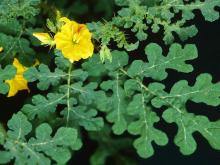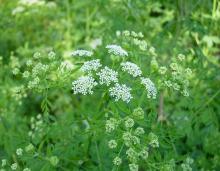Wildflowers, Grasses and Other Nonwoody Plants
Media

Species Types
Scientific Name
Ageratina altissima (formerly Eupatorium rugosum)
Description
White snakeroot looks very similar to thoroughworts, but it has triangular leaf blades that are more broadly angled or rounded at the base. White snakeroot is common statewide. It’s a toxic plant if eaten, so it’s good to be able to identify it.
Media

Species Types
Scientific Name
Delphinium tricorne
Description
Dwarf larkspur is a single-stemmed perennial with an upright flower stalk bearing racemes of bluish-purple flowers. Like other larkspurs, there is a spurlike appendage behind each flower.
Media

Species Types
Scientific Name
Solanum rostratum
Description
A spiny annual with bright yellow flowers and dandelion-like leaves, buffalo bur is an introduced member of the nightshade family.
Media

Species Types
Scientific Name
Datura stramonium
Description
Pretty but poisonous, jimsonweed has white goblet-shaped flowers that open around midnight. This native of tropical America was introduced nearly throughout the United States and thrives in disturbed soils.
Media

Species Types
Scientific Name
Solanum carolinense
Description
Horse nettle is a native perennial with spiny stems and leaves, white to purplish flowers, and toxic fruits that look like tiny yellow tomatoes. It does well in disturbed habitats, and many people consider it a weed.
Media

Species Types
Scientific Name
Cicuta maculata
Description
Full grown, water hemlock looks something like a gigantic Queen Anne's lace, but this common, widespread member of the carrot family is the most toxic plant in North America. All parts are deadly. A piece of root the size of a walnut can kill a cow-sized animal.
Media

Species Types
Scientific Name
Aquilegia canadensis
Description
Native to much of eastern North America, eastern red columbine's range almost matches the breeding territory of the ruby-throated hummingbird, its number-one pollinator. Its bloom time matches the hummingbird's northward migration, too.
Media

Species Types
Scientific Name
Actaea pachypoda
Description
The flower clusters of white baneberry have many white stamens that persist after the petal-like sepals have fallen off. They bear open clusters of white berries with a small purple dot on each one. They look like the porcelain eyes of dolls.
See Also
About Wildflowers, Grasses and Other Nonwoody Plants in Missouri
A very simple way of thinking about the green world is to divide the vascular plants into two groups: woody and nonwoody (or herbaceous). But this is an artificial division; many plant families include some species that are woody and some that are not. The diversity of nonwoody vascular plants is staggering! Think of all the ferns, grasses, sedges, lilies, peas, sunflowers, nightshades, milkweeds, mustards, mints, and mallows — weeds and wildflowers — and many more!





















